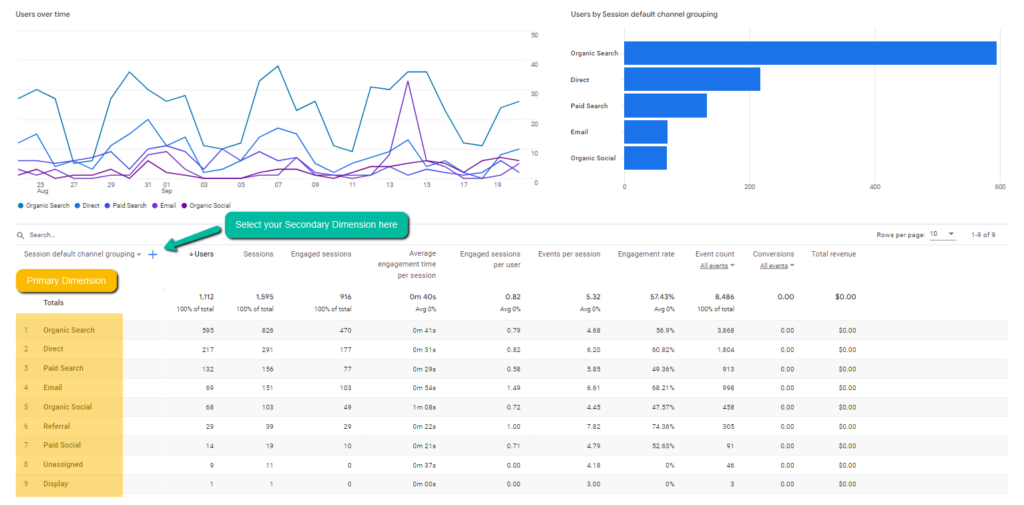Unlocking the Power of Secondary Dimension Analytics for Improved Data Insights and Decision-Making
In the realm of information analytics, main dimensions typically take the limelight, yet real depth of understandings exists within the world of second dimensions. These additional data factors offer a nuanced point of view that can illuminate partnerships and patterns not readily apparent at very first look. By using the power of second measurement analytics, organizations can introduce concealed trends, reveal correlations, and extract more purposeful verdicts from their data. The capacity for boosted decision-making through the utilization of these second measurements is large, assuring a much deeper understanding of intricate information sets and paving the means for more enlightened strategic selections.
Importance of Second Measurements
Exploring the relevance of secondary measurements in analytics reveals the surprise layers of information understandings crucial for notified decision-making in different domains. Additional measurements give a deeper understanding of key information by supplying extra context and viewpoints. By integrating additional measurements into analytics, organizations can draw out more nuanced and detailed understandings from their datasets.
One trick significance of secondary dimensions is their ability to segment and categorize main information, enabling an extra in-depth analysis of details subsets within a dataset. This division allows organizations to identify patterns, fads, and outliers that might not be apparent when taking a look at the data overall. Furthermore, secondary dimensions aid in discovering correlations and reliances between different variables, causing even more exact projecting and predictive modeling.
Additionally, secondary measurements play an important function in boosting data visualization and reporting. By adding second dimensions to visualizations, such as charts or charts, analysts can produce extra informative and insightful depictions of information, promoting much better interaction of findings to stakeholders. Overall, the combination of additional dimensions in analytics is important in opening the complete potential of data and driving evidence-based decision-making.
Trick Benefits of Making Use Of Second Dimensions
Using additional measurements in analytics provides companies a tactical advantage by increasing the deepness and granularity of information understandings. By studying information utilizing second dimensions such as time, location, tool kind, or user demographics, organizations can reveal patterns, trends, and correlations that may otherwise stay surprise.
Furthermore, the usage of second measurements improves the context in which primary data is translated. By leveraging second dimensions in analytics, organizations can harness the full possibility of their data to drive far better decision-making and attain their organization purposes.
Advanced Information Analysis Techniques
A deep dive into sophisticated data analysis strategies discloses innovative approaches for extracting valuable insights from complex datasets. One such technique is maker knowing, where algorithms are used to recognize patterns within information, anticipate end results, and make data-driven decisions. This approach enables the automation of analytical model building, enabling the processing of large quantities of data at a faster rate than typical techniques.
One more innovative technique is anticipating analytics, which uses analytical formulas and artificial intelligence strategies to anticipate future end results based upon historical data. By evaluating patterns i loved this and patterns, services can anticipate customer habits, market trends, and possible threats, equipping them to make proactive choices.
Furthermore, text mining and view evaluation are important methods for extracting understandings from disorganized data sources such as social networks comments, consumer evaluations, and survey feedbacks. By analyzing text data, organizations can comprehend consumer opinions, recognize emerging fads, and enhance their products or solutions based on feedback.
Enhancing Decision-Making Through Additional Dimensions

Enhancing decision-making with second measurements allows services to make more informed and targeted calculated options. As an example, by segmenting customer information based on secondary dimensions like buying history or involvement degrees, firms can customize their advertising methods to details audience segments, bring about boosted conversion rates and client contentment. Secondary dimensions can aid determine connections and connections in between different variables, enabling organizations to make data-driven choices that drive development and success.
Implementing Second Dimension Analytics
When integrating additional dimensions in analytics, companies can open deeper insights that drive tactical decision-making and boost overall efficiency. This involves comprehending the certain questions the company looks for to respond to and the information factors required to resolve them.

Additionally, organizations must utilize progressed analytics tools and innovations to simplify the procedure of incorporating secondary measurements. These tools can automate information handling, analysis, and visualization, enabling organizations to concentrate on analyzing insights instead than hands-on information control.
Final Thought
To conclude, anonymous second measurement analytics play an important function in boosting data insights and decision-making processes. By making use of sophisticated information evaluation methods and implementing secondary measurements properly, companies can unlock the power of their information to drive tactical organization choices. The crucial benefits of using additional dimensions can not be overstated, as they offer a deeper understanding of data patterns and partnerships. It is vital for companies to take advantage of additional measurement analytics to remain competitive in today's data-driven landscape.
In the realm of data analytics, key measurements usually take the limelight, however the real depth of understandings exists within the world of additional dimensions.Making use of additional dimensions in analytics offers organizations a tactical benefit by enhancing the deepness and granularity of data understandings. By leveraging secondary dimensions in analytics, companies can harness the complete potential of their information to over here drive better decision-making and attain their business goals.
Applying information validation procedures and regular audits can help keep data high quality and reliability.
By utilizing sophisticated data evaluation techniques and executing secondary dimensions efficiently, companies can unlock the power of their information to drive calculated organization decisions.